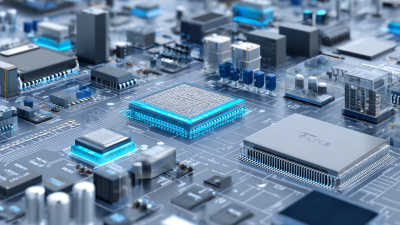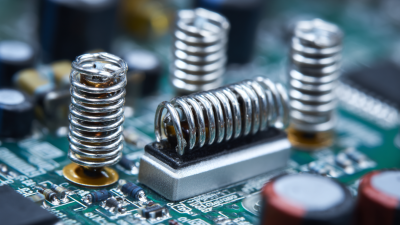News / Blog
Understanding the Evolution of Electric Switches in Modern Technology
The evolution of electric switches has been a pivotal aspect of modern technological advancement, driving innovation across various industries. As the global demand for energy efficiency and smart systems continues to surge, the electric switches market is projected to reach a staggering $66.5 billion by 2025, according to a recent report by Fortune Business Insights. This underscores the increasing significance of electric switches not just as mere components, but as integral elements in energy management systems and automation solutions. With advancements in smart technologies, such as IoT and AI, electric switches are evolving to enhance connectivity and user experience, facilitating the development of smarter homes and industries. Understanding their historical progression and current trends is essential for stakeholders aiming to leverage these technologies for optimized performance and sustainability in an ever-changing digital landscape.

The Historical Overview of Electric Switches in Technological Progress
The evolution of electric switches is intricately tied to the advancements in technology, shaping our modern infrastructure. Historically, electric switches, which are critical in controlling the flow of electricity, have seen significant innovations from simple manual toggles to sophisticated smart systems. The electric switch market is expected to witness substantial growth in the U.S., driven by increasing demand for energy-efficient solutions, advancements in smart home technologies, and governmental initiatives promoting sustainable infrastructure. According to industry reports, the electric switch sector is poised for robust expansion, influenced by strategic investments in infrastructure development.
As we advance, consumers are increasingly drawn to smart switches that promise enhanced energy efficiency and convenience. The global high voltage switch market, particularly in regions such as China, is projected to exhibit a growth rate of over 5% annually, driven by heightened urbanization and infrastructural investments. Businesses aiming to stay competitive should consider adopting energy-efficient technologies to meet market demands.
**Tips:** When selecting electric switches for your property, consider the benefits of energy-efficient models that can reduce consumption and lower utility bills. Additionally, integrating smart home capabilities not only adds convenience but also enables better energy management. Investing in high-quality switches now can lead to long-term savings and a smaller carbon footprint.
Evolution of Electric Switches Over the Years
This chart illustrates the increase in the number of patents filed for electric switches over the decades, showcasing the rapid technological advancements in this field from the 1880s to the present day. The significant growth in patent filings reflects the evolving technology and increasing demand for efficient electric switching solutions in modern applications.
Key Innovations that Shaped Modern Electric Switch Design
The evolution of electric switches reflects the rapid advancements in modern technology, driven by key innovations that have shaped their design and functionality. One significant innovation is the introduction of microprocessor-controlled switches, which have not only enhanced the precision of electrical control but have also enabled smart home applications. According to a report by MarketsandMarkets, the global smart switch market is projected to grow from $4.80 billion in 2020 to $10.95 billion by 2025, highlighting the increasing reliance on smart technology in our everyday lives.

Another pivotal development has been the miniaturization of components, allowing for more compact switch designs without sacrificing performance. This trend is evident in sectors like consumer electronics, where space is a premium. The International Electrotechnical Commission (IEC) has noted that compact switch designs improve energy efficiency by streamlining the pathway for electrical flow, which contributes to overall device performance. As industries adopt these innovations, the demand for high-performance, space-saving electric switches continues to rise, shaping the future of electrical engineering and device design.
The Role of Smart Technology in the Evolution of Switches
The evolution of electric switches has been significantly influenced by the advent of smart technology. Traditional switches, primarily mechanical in nature, have given way to smarter, more versatile devices that integrate seamlessly with home automation systems. These modern switches not only enhance user convenience but also contribute to energy efficiency by allowing users to control lighting and appliances remotely through smartphones or voice commands. This shift reflects a broader trend towards interconnected devices that improve our daily lives.

Tip: When considering the upgrade to smart switches, check for compatibility with existing smart home ecosystems, such as Google Home or Amazon Alexa, to ensure seamless integration and optimal functionality.
Moreover, smart switches offer advanced features like scheduling and programmable settings, enabling users to automate their home environments effortlessly. The ability to monitor energy usage in real-time provides invaluable insights that can lead to more sustainable living practices. As we embrace this technological evolution, it becomes crucial to prioritize security by selecting switches with robust encryption and user authentication mechanisms.
Tip: Always read reviews and research different smart switch brands to find those that offer the best security features and customer support.
Comparative Analysis of Analog vs. Digital Electric Switches
The evolution from analog to digital electric switches represents a significant transformation in modern technology, with profound implications for various industries, particularly in the telecommunications and electronic sectors. According to a recent market research study by Custom Market Insights, the global industrial Ethernet switch market is projected to reach a worth of USD 6.8 billion by 2032, growing at a compound annual growth rate (CAGR) of 7.1%. This growth is fueled by the increasing demand for reliable and efficient network infrastructure, promoting a shift from traditional analog systems to more sophisticated digital solutions.
The comparative analysis between analog and digital electric switches reveals several advantages and disadvantages inherent to each. Digital switches offer enhanced functionality, superior signal integrity, and the ability to interface seamlessly with modern digital systems, making them ideal for contemporary applications. On the other hand, while analog switches can be simpler and less expensive, their limitations in performance and scalability hinder their use in environments that demand high precision and efficiency. As the industry moves towards increasingly complex operational landscapes, the implications of these transitions become ever more critical, further solidifying the role of digital technology in future developments.
Future Trends: What’s Next for Electric Switch Technology?
The electric switch technology landscape is primed for significant advancements owing to a growing demand for energy-efficient solutions, the rise of smart home technologies, and government initiatives to promote sustainable infrastructure. As the U.S. electric switch market embraces these trends, substantial investment in infrastructure is anticipated to drive robust growth. This evolution reflects a broader commitment to modernize energy distribution and optimize power consumption, addressing both consumer needs and environmental concerns.
In the context of global markets, the DC switchgear sector illustrates this momentum, with a projected compound annual growth rate of 4.3%. By 2024, the market is expected to reach approximately $143.5 billion, further expanding to nearly $200.996 billion by 2032. This uptick is indicative of the increasing adoption of advanced electrical equipment crucial for efficient energy transmission and distribution. The upcoming forums and exhibitions, such as the China Electric Industry Development Forum, will serve as catalysts for innovation in the industry, spotlighting how technologies like AI can enhance the development paths of electric switch equipment toward greener futures.
Related Posts
-

Why Electronic Capacitors Are Essential for Modern Electronics
-

Why Understanding Electric Switches is Essential for Modern Homes
-

Navigating Trends in Electronic Components at the 138th Canton Fair 2025 in China
-

How to Optimize Electronic Resistors for Improved Circuit Performance and Reliability
-

How to Navigate the Best Electronic Components Website for Your Project Needs
-

Exploring Market Trends for Electronic Sensors at China's 138th Canton Fair 2025: Insights and Data
